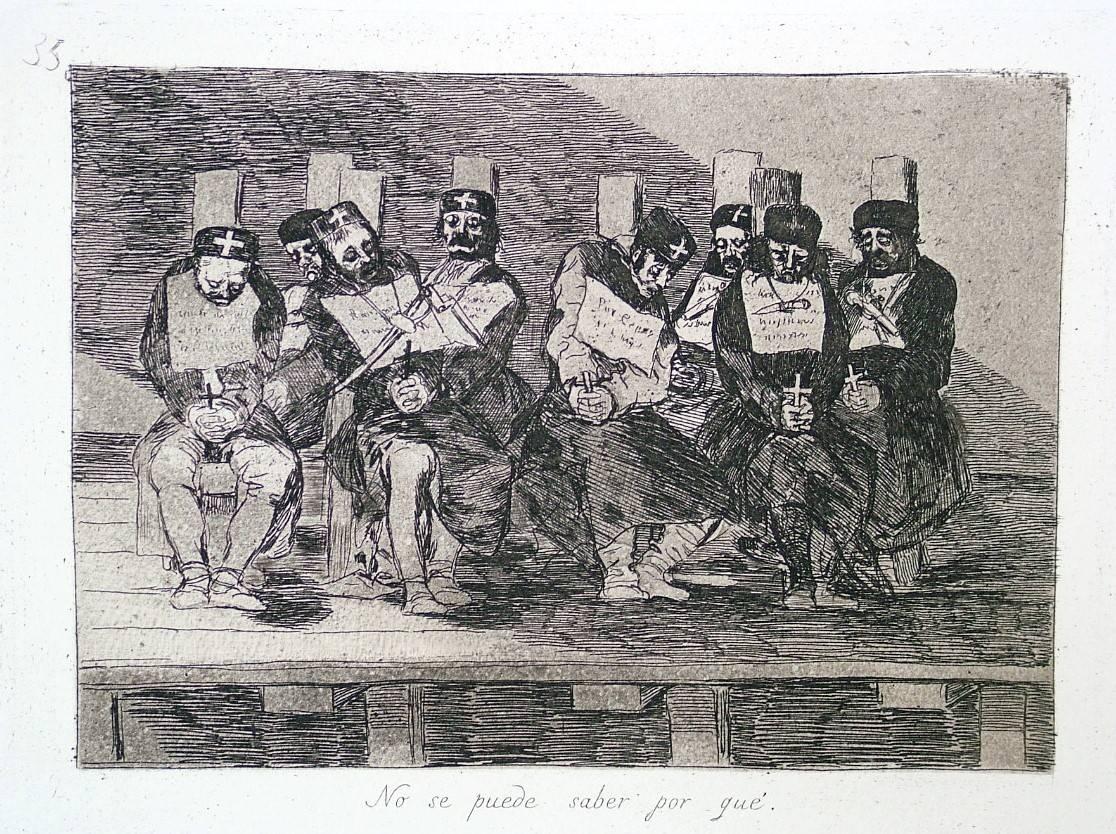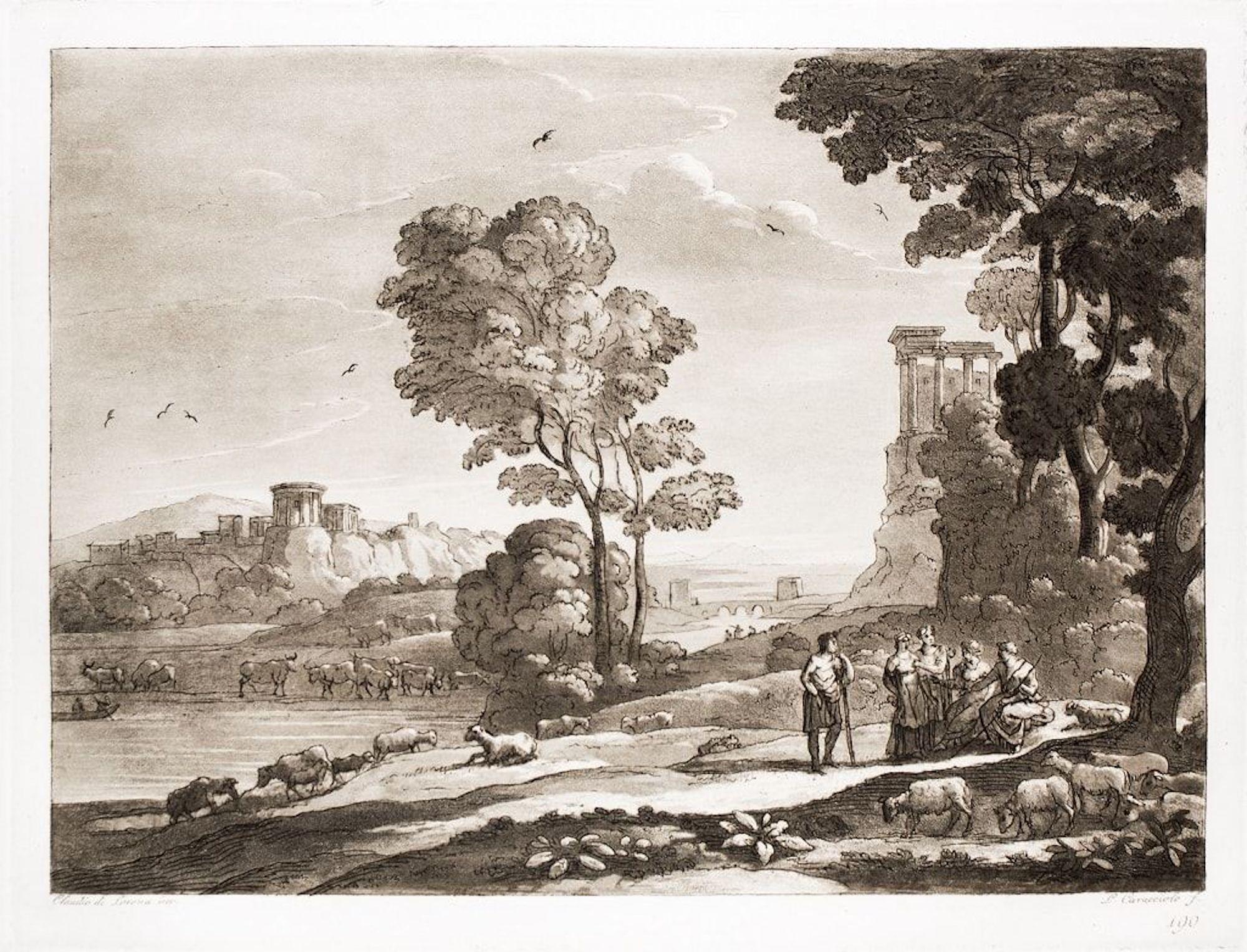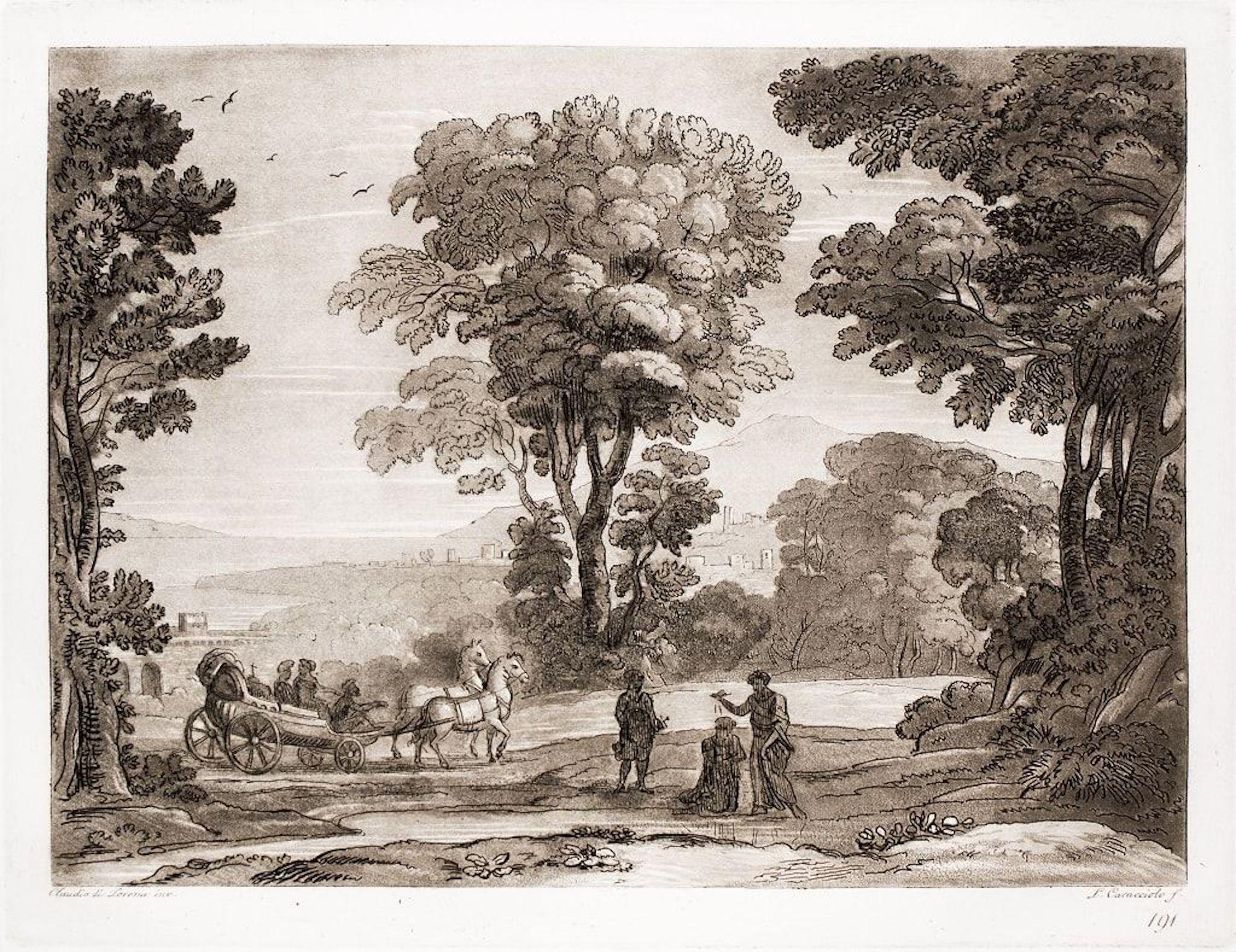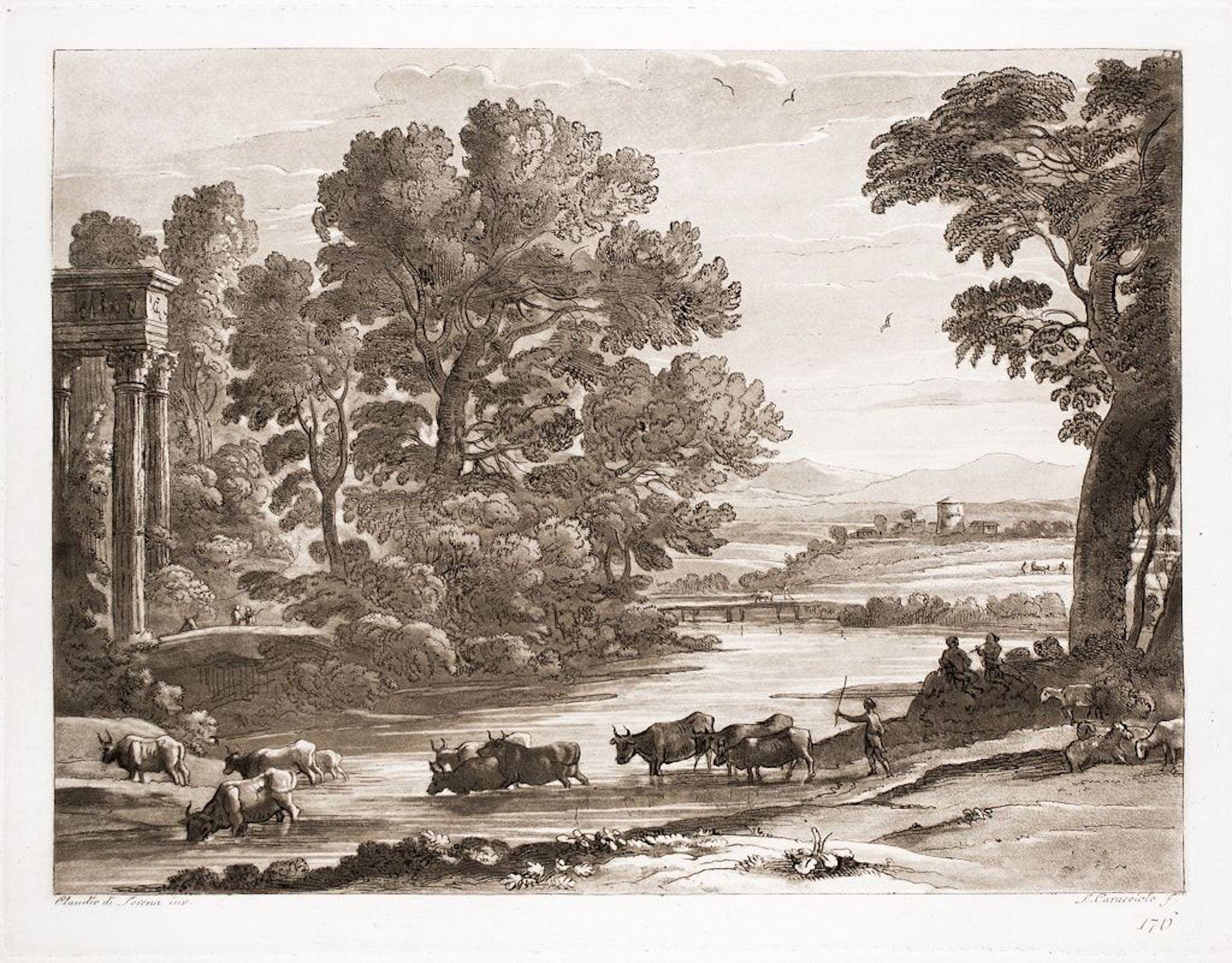Items Similar to El Vergponzoso (The Shamefaced One)
Want more images or videos?
Request additional images or videos from the seller
1 of 7
Francisco GoyaEl Vergponzoso (The Shamefaced One)1799
1799
About the Item
El Vergponzoso (The Shamefaced One)
etching & aquatint, 1799
Unsigned (as are all Goya etchings)
From: Los Caprichos, Plate 54
From the First Edition, printed 1799, on laid paper
Reference: harris 89 iii/III, first edition printed 1799
Very fine impression with strong contrast in the aquatint.
Condition: Printed on laid paper, before the beveling of the plate in the Fourth edition. Reduced, but ample margins. Fine impression with strong contrast of the aquatint.
Plate: 8 7/16 x 5 7/8 inches
Sheet: 11 7/16 x 7 7/8 inches
- Creator:Francisco Goya (1746 - 1928, Spanish)
- Creation Year:1799
- Dimensions:Height: 8.44 in (21.44 cm)Width: 5.88 in (14.94 cm)
- Medium:
- Movement & Style:
- Period:1790-1799
- Condition:
- Gallery Location:Fairlawn, OH
- Reference Number:
Francisco Goya
Francisco José de Goya y Lucientes (1746-1828) was a Spanish romantic painter and printmaker. He is considered the most important Spanish artist of the late 18th and early 19th centuries. His works often contained a social message, like in his "Disasters of War" series. Immensely successful in his lifetime, Goya is often referred to as both the last of the Old Masters and the first of the moderns. He was also one of the great portraitists of his time.
About the Seller
5.0
Recognized Seller
These prestigious sellers are industry leaders and represent the highest echelon for item quality and design.
Platinum Seller
These expertly vetted sellers are 1stDibs' most experienced sellers and are rated highest by our customers.
Established in 1978
1stDibs seller since 2013
713 sales on 1stDibs
Typical response time: 1 hour
Associations
International Fine Print Dealers Association
- ShippingRetrieving quote...Ships From: Fairlawn, OH
- Return PolicyA return for this item may be initiated within 10 days of delivery.
More From This SellerView All
- Marble relief of a trireme from the Temple of Fortuna, Praeneste, from VasiBy Giovanni Battista PiranesiLocated in Fairlawn, OHMarble relief of a trireme from the Temple of Fortuna, Praeneste, from Vasi, candelabri, cippi, sarcofagi, tripodi, lucerne, ed ornamenti antichi disegnati ed incisi dal Cav. Gio. Ba...Category
1770s Old Masters Figurative Prints
MaterialsEtching
- BacchanalBy Giovanni Andrea PodestàLocated in Fairlawn, OHBacchanal Etching, 1649 Inscribed in the square left: "Magnificentis/simo Principi/Paolo lorda/no. II Bracci/ani Duci/Aud. P.DDD/1640; Inscribed on right: Rome apud Franciscsum Saluu...Category
17th Century Old Masters Figurative Prints
MaterialsEtching
- BacchanalBy Giovanni Andrea PodestàLocated in Fairlawn, OHBacchanal Etching, 1649 Inscribed in the square left: "Magnificentis/simo Principi/Paolo lorda/no. II Bracci/ani Duci/Aud. P.DDD/1640; Inscribed on right: Rome apud Franciscsum Saluu...Category
17th Century Old Masters Figurative Prints
MaterialsEtching
- L'Aieule (The Grandmother)By Louis LegrandLocated in Fairlawn, OHL'Aieule (The Grandmother) Etching and aquatint printed in colors, 1904 Signed with the red stamp of the publisher, Gustave Pellet, Lugt 1193 and numbered (see photo) Edition: 100 (81/100) Reference: Arwas 202 iv/IV IFF 98 Condition: Excellent, the sheet aged as usual Image size: 14 1/4 x 18 5/8" Sheet size: 16 15/16 x 24 1/4" Louis Auguste Mathieu Legrand (29 September 1863 – 1951) was a French artist, known especially for his aquatint engravings, which were sometimes erotic. He was awarded the Légion d'honneur for his work in 1906. Life Legrand was born in the city of Dijon in the east of France. He worked as a bank clerk before deciding to study art part-time at Dijon's Ecole des Beaux-Arts. He won the Devosge prize at the school in 1883.[2] In 1884 Legrand studied engraving under the Belgian printmaker Félicien Rops. Legrand's artworks include etchings, graphic art and paintings. His paintings featured Parisian social life. Many were of prostitutes, dancers and bar scenes, which featured a sense of eroticism. According to the Hope Gallery, "Louis Legrand is simply one of France's finest early twentieth century masters of etching." His black and white etchings especially provide a sense of decadence; they have been compared to those of Henri de Toulouse-Lautrec, though his drawings of the Moulin Rouge, the can-can dance and the young women of Montmartre preceded Toulouse-Lautrec's paintings of similar scenes. He made over three hundred prints of the night life of Paris. They demonstrate "his remarkable powers of observation and are executed with great skill, delicacy, and an ironic sense of humor that pervades them all." Two of his satirical artworks caused him to be tried for obscenity. The first, "Prostitution" was a symbolic drawing which depicted a naked girl being grasped by a dark monster which had the face of an old woman and claws on its hands; the second, "Naturalism", showed the French novelist Émile Zola minutely studying the thighs of a woman with a magnifying glass. Defended by his friend the lawyer Eugène Rodrigues-Henriques (1853–1928), he was found not guilty in the lower court, but was convicted in the appeal court and then given a short prison sentence for refusing to pay his fine. Legrand was made famous by his colour illustrations for Gil Blas magazine's coverage of the can-can, with text by Rodrigues (who wrote under the pseudonym Erastene Ramiro). It was a tremendous success, with the exceptional quantity of 60,000 copies of the magazine being printed and instantly sold out in 1891. In 1892, at the instigation of the publishing house Dentu, Legrand made a set of etchings of his Gil Blas illustrations. The etchings were published in a book, Le Cours de Danse Fin de Siecle (The End of the Century Dance Classes). Legrand took a holiday in Brittany, which inspired him to engrave a set of fourteen lithographs of simple country life called Au Cap de la Chevre (On Goat Promontory). It was published by Gustave Pellet who became a close friend of Legrand's. Pellet eventually published a total of 300 etchings by Legrand, who was his first artist; he also published Toulouse-Lautrec and Félicien Rops among others. He did not only work in graphics; he exhibited paintings at the Paris salon of the Société Nationale des Beaux-Arts starting in 1902. In 1906 he was made a chevalier of the Légion d'honneur. Legrand died in obscurity in 1951. A retrospective exhibition was held at the Félicien Rops museum in Namur, Belgium in 2006 to celebrate his graphic art. The art collector Victor Arwas published a catalogue raisonné for the occasion. Books illustrated de Maupassant, Guy: Cinq Contes Parisiens, 1905. Poe, Edgar Alan: Quinze Histoires d'Edgar Poe...Category
Early 1900s Art Nouveau Figurative Prints
MaterialsAquatint
- Danseuses s'habillant (Laurence adjusting her hair and Mignon adjusting clothesBy Louis LegrandLocated in Fairlawn, OHDanseuses s'habillant (Laurence adjusting her hair and Mignon adjusting hre clothes) Drypoint & aquatint, 1893 Signed in the plate (see photo) After the division of the plate into A. 81 (as here) and A. 82 Divant la glace Editon 100 printed on velin paper Issued by Pellet in the set, Les Petites du Ballet, Gustave Pellet editeur, 1893 (13 plates), second state (b) without remarque Reference: Arwas 81, top portion of the plate vii/VIII Plate/Image size: 6 x 8 7/16 inches Condition: excellent Louis Auguste Mathieu Legrand (29 September 1863 – 1951) was a French artist, known especially for his aquatint engravings, which were sometimes erotic. He was awarded the Légion d'honneur for his work in 1906. Life Legrand was born in the city of Dijon in the east of France. He worked as a bank clerk before deciding to study art part-time at Dijon's Ecole des Beaux-Arts. He won the Devosge prize at the school in 1883.[2] In 1884 Legrand studied engraving under the Belgian printmaker Félicien Rops. Legrand's artworks include etchings, graphic art and paintings. His paintings featured Parisian social life. Many were of prostitutes, dancers and bar scenes, which featured a sense of eroticism. According to the Hope Gallery, "Louis Legrand is simply one of France's finest early twentieth century masters of etching." His black and white etchings especially provide a sense of decadence; they have been compared to those of Henri de Toulouse-Lautrec, though his drawings of the Moulin Rouge, the can-can dance and the young women of Montmartre preceded Toulouse-Lautrec's paintings of similar scenes. He made over three hundred prints of the night life of Paris. They demonstrate "his remarkable powers of observation and are executed with great skill, delicacy, and an ironic sense of humor that pervades them all." Two of his satirical artworks caused him to be tried for obscenity. The first, "Prostitution" was a symbolic drawing which depicted a naked girl being grasped by a dark monster which had the face of an old woman and claws on its hands; the second, "Naturalism", showed the French novelist Émile Zola minutely studying the thighs of a woman with a magnifying glass. Defended by his friend the lawyer Eugène Rodrigues-Henriques (1853–1928), he was found not guilty in the lower court, but was convicted in the appeal court and then given a short prison sentence for refusing to pay his fine. Legrand was made famous by his colour illustrations for Gil Blas magazine's coverage of the can-can, with text by Rodrigues (who wrote under the pseudonym Erastene Ramiro). It was a tremendous success, with the exceptional quantity of 60,000 copies of the magazine being printed and instantly sold out in 1891. In 1892, at the instigation of the publishing house Dentu, Legrand made a set of etchings of his Gil Blas illustrations. The etchings were published in a book, Le Cours de Danse Fin de Siecle (The End of the Century Dance Classes). Legrand took a holiday in Brittany, which inspired him to engrave a set of fourteen lithographs of simple country life called Au Cap de la Chevre...Category
1890s Art Nouveau Figurative Prints
MaterialsAquatint
- TrioBy Georges RouaultLocated in Fairlawn, OHTrio Color aquatint, 1938 Edition 250 printed on Montval wove paper with Maillol watermark From: Les Fleurs de Mal III (12 color aquatints) Published by A...Category
1930s French School Figurative Prints
MaterialsAquatint
You May Also Like
- One Can't Tell Why - Proof from the Disasters of WarBy Francisco GoyaLocated in New York, NYFrancisco José de Goya y Lucientes (1746 Fuendetodos – Bordeaux 1828), No se puede saber por qué – One can’t tell why ca. 1808–1814, etching, burnished aquatint, drypoint, an...Category
1810s Old Masters Figurative Prints
MaterialsDrypoint, Etching, Aquatint
- Liber Veritatis - Original B/W Etching after Claude Lorrain - 1815By Ludovico CaraccioloLocated in Roma, ITImage dimensions: 21 x 27 cm. Liber Veritatis - Plate 95 is a beautiful black and white etching and aquatint on paper realized by the Italian artist Ludovico Caracciolo, after Claud...Category
1810s Old Masters Figurative Prints
MaterialsAquatint, Etching
- Liber Veritatis - Original B/W Etching after Claude Lorrain - 1815By Ludovico CaraccioloLocated in Roma, ITImage dimensions: 21 x 27 cm. Liber Veritatis - Plate 190 is a beautiful black and white etching and aquatint on paper realized by the Italian artist Ludovico Caracciolo, after Clau...Category
1810s Old Masters Figurative Prints
MaterialsAquatint, Etching
- Liber Veritatis - Original B/W Etching after Claude Lorrain - 1815By Ludovico CaraccioloLocated in Roma, ITImage dimensions: 21 x 27 cm. Liber Veritatis - Plate 191 is a beautiful black and white etching and aquatint on paper realized by the Italian artist ...Category
1810s Old Masters Figurative Prints
MaterialsAquatint, Etching
- Liber Veritatis - Original B/W Etching after Claude Lorrain - 1815By Ludovico CaraccioloLocated in Roma, ITImage dimensions: 21 x 27 cm. Liber Veritatis - Plate 176 is a beautiful black and white etching and aquatint on paper realized by the Italian artist ...Category
1810s Old Masters Figurative Prints
MaterialsAquatint, Etching
- Liber Veritatis - Original B/W Etching after Claude Lorrain - 1815By Ludovico CaraccioloLocated in Roma, ITImage dimensions: 21 x 27 cm. Liber Veritatis - Plate 145 is a beautiful black and white etching and aquatint on paper realized by the Italian artist Ludovico Caracciolo, after Clau...Category
1810s Old Masters Figurative Prints
MaterialsAquatint, Etching






